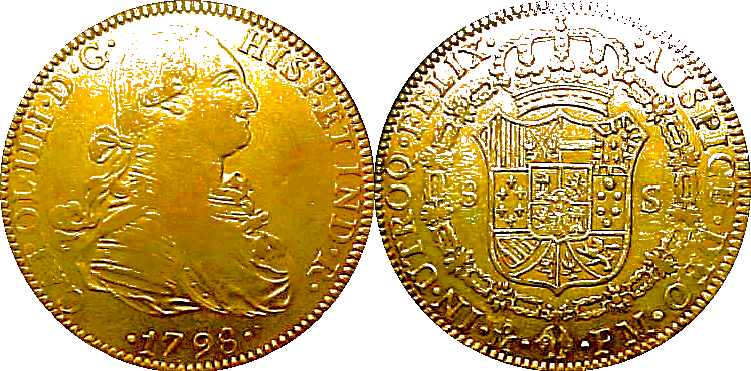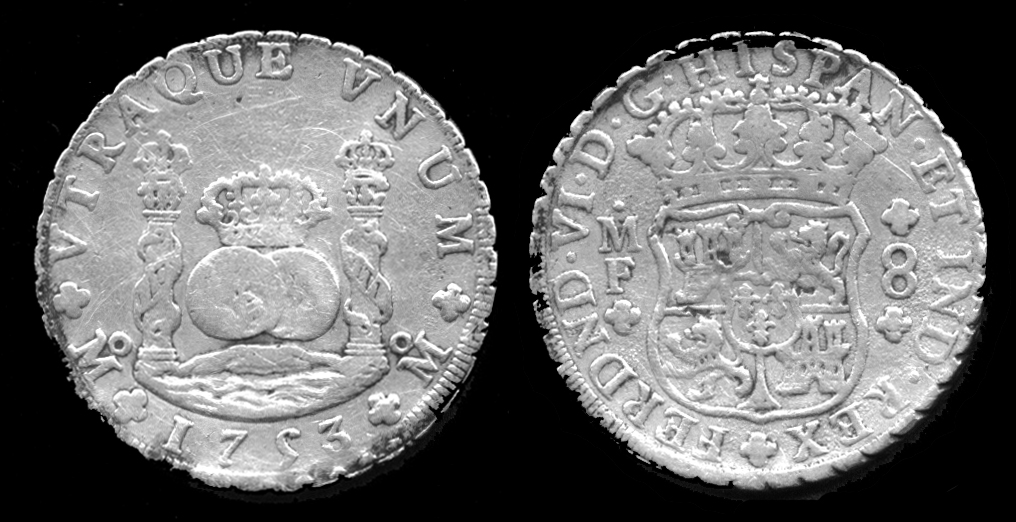|

Coins
minted in gold are actually worth something, unlike paper currency based on
worthless promises
In
days gone by they traded in real money based on solid gold and silver minted
coins. Today, paper currency is based on worthless promises, by governments
that are typically corrupt is some measure; political pirates, racking up
staggering national debts, based on flawed policies.
The
best known golden treasures are Doubloons, Guineas and Sovereigns.
THE
GOLDEN GUINEA
The guinea was a coin, minted in Great Britain between 1663 and 1814, that contained approximately one-quarter of an ounce of gold. The name came from the Guinea region in West Africa, from where much of the gold used to make the coins was sourced. It was the first English machine-struck gold coin, originally worth one pound sterling, equal to twenty shillings, but rises in the price of gold relative to silver caused the value of the guinea to increase, at times to as high as thirty shillings. From 1717 to 1816, its value was officially fixed at twenty-one shillings.
When Britain adopted the gold standard the guinea became a colloquial or specialised term. Although the coin itself no longer circulated, the term guinea survived as a unit of account in some fields. Notable usages included professional fees (medical, legal, etc.), which were often invoiced in guineas, and horse racing and greyhound racing, and the sale of rams. In each case a guinea meant an amount of one pound and one shilling (21 shillings), or one pound and five pence (£1.05) in decimalised currency. The name also forms the basis for the Arabic word for the Egyptian pound الجنيه el-Genēh / el-Geni, as a sum of 100 qirsh (one pound) was worth approximately 21 shillings at the end of the 19th century.
THE DOUBLOON
The doubloon (from Spanish doblón, or "double", i.e. double escudo) was a two-escudo gold coin worth approximately $4 (four Spanish dollars) or 32 reales, and weighing 6.766 grams (0.218 troy ounce) of 22-karat gold (or 0.917 fine; hence 6.2 g fine gold).
Doubloons were minted in Spain and the viceroyalties of New Spain, Peru, and Nueva Granada (modern-day Colombia, Ecuador, Panama, and Venezuela). As the Spanish escudo succeeded the heavier gold excelente (or ducado, ducat; 3.1 g vs 3.48 g fine gold) as the standard Spanish gold coin, the doubloon therefore succeeded the doble excelente or double-ducat denomination.
In modern times, the doubloon is remembered due in large part to the influence of historical fiction about piracy.
THE SOVEREIGN
The very first gold Sovereign was struck during Henry VII’s reign. On 28th October 1489, the king ordered the officers of his Royal Mint to produce “A new money of gold.”
Up to that point, gold coins had been in circulation for over a hundred years, so the Sovereign certainly wasn’t the first gold coin to be minted in England. It was, however, the largest and most valuable ever seen at that time. On the obverse of the coin there was a portrait of Henry VII on his throne, wearing his coronation gown. The royal arms featured on the reverse, with a magnificent double rose that symbolised the union of York and Lancaster after the Wars of the Roses.
This large, handsome coin clearly sent out a message of stability and prestige after the turmoil of the wars. Succeeding monarchs all chose to strike new versions of the Sovereign themselves, indicating their own power and strength. It wasn’t until the reign of James I, crowned King of England and Scotland in 1603, that the practice died out.
One of the most widely traded gold coins in the world, the gold sovereign is always a popular choice with investors because of its status as legal tender in the UK which makes it exempt from Capital Gains Tax (CGT). The gold sovereign is predominately produced by the Royal Mint in the UK, but also by royally sanctioned Mints in Australia, India, Canada and South Africa. Regardless of where the gold sovereign is produced, it will always carry the British design and therefore remain legal tender with a nominal value of £1 Sterling. Struck in 22ct Gold and weighing 7.98grams the Gold Sovereign would be a great addition to any gold collection.
Other
forms of transportable money are diamonds, rubies and
emeralds.
Pieces
of Eight are coins, also known as
the Spanish Dollar.

Abraham
Gray - Ships carpenter
Ben
Gunn - Marooned pirate
Billy
Bones - Former mate of Captain Flint
Black
Dog - Pirate
Blind
Pew - Pirate
Captain
Alexander Smollett - Hispaniola captain
Captain
Joseph Flint - Deceased pirate, owner of buried treasure chest and map
Dick
Johnson - Is a young pirate with a Bible
Doctor
David Livesey - Medical man and magistrate
George
Merry - A mutinous pirate
Hispaniola
- The sailing ship hired for the adventure
Jim
Hawkins - Cabin boy
Job
Anderson - Ship's boatswain
John
Hunter - Squire Trelawney's manservant
Israel
Hands - Ship's coxwain, mate of Captain Flint
Long
John Silver
Richard
Joyce - Valet to Squire Trelawney
Squire
John Trelawney
Tom
Morgan - Pirate friend of Captain Flint
Tom
Redruth - Gamekeeper
Treasure
Island was written by Robert Louis
Stevenson, becoming an instant hit,
popular with children and adults, the subject of many films and graphic
novels.
.....
|

